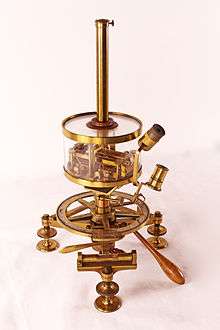Johann Michael Ekling
Johann Michael Ekling (also spelt Eckling) (8 August 1795, Matzleinsdorf – 30 March 1876, Landstraße) was an Austrian mechanic and inventor of scientific apparatuses and instruments.[1]

Life
Johann Michael Ekling was the posthumous son of the army surgeon Joseph Ekling. His mother was Anna Maria Eurosina Ekling née Stitzbarth. He was born in the suburb of Matzleinsdorf (today a part of Margareten) in Vienna. At the age of 33 he married Theresia Schwarz with whom he had five sons and a daughter. In the years to follow he cooperated closely with mathematics and physics professors Andreas von Baumgartner (German Wikipedia)[2] and Andreas von Ettingshausen of the University of Vienna. He produced artificial magnets on behalf of Baumgartner[3] and one of the first photographic apparatuses in Austria (1839)[4] following instructions by Ettingshausen,[5] who had worked with Daguerre. By 1844 he is referred to as a "university mechanic".[6] An announcement in a paper describes his range of products as follows: "[Ekling] makes all sorts mathematical and physical instruments and apparatuses, air pumps with glass barrel chambers, travel barometers, goniometers,[7] chemical and mineralogical apparatuses".[8] His multiplicator was used for the analysis of mineral waters among other things and praised for its sensitivity.[9] Ekling was granted patents for induction machines, cameras and improvements to the Bain telegraph, which were taken over by the Austrian railway. Ekling’s last invention was a "Galvanic Induction Machine for Medical Purposes".[10]
His reputation as a mechanic is documented in the Austrian Law Gazette for 1850: "The most recommendable mechanic in Vienna, and as regards more sophisticated optical equipment, the only one to be recommended, is Eckling."[11] Among these instruments we find the heliostat in the picture alongside.[12] Young mechanics from Germany like Rudolph Carl Adolph Dolberg (1817-1863) and Adolph Hermann Friedrich Petri (1819-1895)[13] were apprenticed to Ekling. Johann Leopolder, who later ran his own large Telegraph and Telephone Company was also one of his apprentices and later his foreman, until he started his own establishment in 1850.[14] In 1860 Ekling sold his premises at 25 Erdbergstrasse to his neighbour Rudolf Ditmar who owned a rapidly expanding kerosine lamp factory.[15] He died a gentleman of independent means at Landstrasse/Vienna in 1876.
Literature
- Franz Pichler, Die Einführung der Morse-Telegraphie in Deutschland und Österreich. e&i elektrotechnik und informationstechnik, issue 9, 2006, p. 402–408
- Franz Pichler, Elektrisches Schreiben in die Ferne: die Telegraphie in Österreich: technische Entwicklung, 1846–1906., Linz 2007
- Baron Charles von Reichenbach, Physico-physiological Researches on the Dynamics of Magnetism, Electricity, Heat, Light, Chrystallization and Chemism, London 1850
External links
Instruments and apparatuses made by Ekling are in various physics collections in Austria (Innsbruck, Kremsmünster Observatory For a list of acquisitions see: [16] Linz and Vienna, Czech Republic (Prague), Germany (Augsburg and Munich), Italy (Venice) and the USA (Kenyon College, OH).
References
- Dates of birth and death of Ekling and his family were ascertained in the online archives of the Catholic diocese of Vienna. See http://matricula-online.eu//
- Electromagnetic apparatus built for Baumgartner in 1830 (University of Innsbruck)
- Wiener Zeitung of 26 January 1833, p. 95
- Emil-Heinz Schmitz, Handbuch zur Geschichte der Optik: Das XIX. Jahrhundert, Bonn 1983, p. 9
- Bohemia: oder Unterhaltungsblätter für gebildete Stände, 1840; no page number
- Verhandlungen der k.k. Gesellschaft der Ärzte zu Wien, Vienna 1844, p. 25
- Ekling built this instrument according to instructions received from Friedrich Mohs (1773-1839)
- Notizen über Produktion, Kunst, Fabriken und Gewerbe, Wien 1833, p. 48
- Adolph Pleischl, Ueber die Thermalwasser zu Gastein und Carlsbad in chemisch-physicalischer Hinsicht, 1846, p. 6
- Insert to Faust. Poligrafisch-illustrirte Zeitschrift für Kunst, Wissenschaft, Industrie und Unterhaltung, 1854; no page
- Gesetzblatt für das Land Österreich, 1850, p. 542
- A. Adolf Schmid, Wien und seine nächsten Umgebungen mit besonderer Berücksichtigung wissenschaftlicher Anstalten und Sammlungen, Vienna 1852, p. 92.
- Jürgen Hamel, Über die mechanisch-optischen Werkstätten "Dolberg" und "Dolberg & Petri" in Rostock
- Die Gross-Industrie Österreichs, vol. 3, 1898, p. 250.
- Wiener Geschichtsblätter, vol. 56, issues 1-4, Verein für Geschichte der Stadt Wien, 2001, p. 3
- Sigmund Fellöcker, Geschichte der Sternwarte der Benediktiner-Abtei Kremsmünster, Linz 1864, pp. 304–310